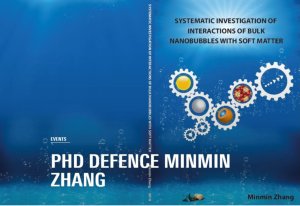This thesis attempts a systematic study of interactions of bulk nanobubbles with a series of soft matter systems, including various colloidal suspensions, liposomes and viral capsid proteins.
A variety of applications
 ‘These bubbles are attractive for many applications,’ says Minmin Zhang. ‘One could think of industrial processes such as: cleaning, froth flotation and wastewater treatment. Also in biomedical fields the study is relevant such as in: ultrasound contrast agents, drug delivery and disease diagnosis.’
‘These bubbles are attractive for many applications,’ says Minmin Zhang. ‘One could think of industrial processes such as: cleaning, froth flotation and wastewater treatment. Also in biomedical fields the study is relevant such as in: ultrasound contrast agents, drug delivery and disease diagnosis.’
First the focus was on the interaction of bulk nanobubbles with negatively charged Au (gold) nanoparticles. The resulting Au nanoparticle-nanobubble interaction suggests a scenario of nucleation and growth of nanobubbles directly on nanoparticles.
As a next step, the interaction with positively charged amidine polystyrene beads over a range of sizes was explored. ‘Then we moved onto liposomes in bulk solutions,’ Minmin says. ‘In both stages of research we used a wide variety of experimental techniques. We also gained insight into the phenomenology of interactions of bulk nanobubbles with organic systems.’
As the interactions of bulk nanobubbles with charged particles in both organic and inorganic systems are very strong, Minmin believes this will benefit the existing nanobubble-relevant applications. For example in the cleaning sector, using environmentally friendly nanobubble solutions generated by water electrolysis, the results may improve further still. ‘The simplicity of the system and the more profound knowledge we gained, ensures its potential applications here and in various other fields.’
Viral capsid proteins
In her PhD work, Minmin extended her work towards studying bulk nanobubble-induced self-assembly of viral capsid proteins. ‘These were disassembled and purified from native cowpea chlorotic mottle virus (CCMV),’ Minmin says. ‘We addressed the successful self-assembly of capsid proteins by three distinct techniques: dynamic light scattering, atomic force microscopy, and transmission electron microscopy.’
‘In this process, bulk nanobubbles played a role as templates. On this issue I collaborated with the Biomolecular Nanotechnology Group. We succeeded to address the ability of bulk nanobubbles to drive the self-assembly of viral capsid protein in quite some detail.’
Supervisor
Within her own Group (Bioelectronics), Minmin appreciated the constant scientific input from her supervisor Professor Serge Lemay. ‘He also guided me how to write a proper scientific article,’ she says. ‘He was always willing to read my concepts and make corrections and giving me advice.’
Being an experimentalist by nature, Minmin was happy to share her experimental techniques, for example nanotracking analysis (coming from the BioNanolab) and size characterisation techniques (coming from her own group) to her colleagues. ‘Vice versa, colleagues helped me prepare the samples following the specifications I needed for my experiments.’
Taking notes
Minmin: ‘I learnt that - both in the experimental and in the theoretical work - taking notes is of vital importance. No matter how good your memory is, it will never be good enough. You really need the input that you have written down systematically one day. I also capture on paper the progress I make in generating and gaining new knowledge. It is vital to organize what you have learnt. I developed a good routine in doing so, which helped – and still helps – me a lot. Comparing, categorizing, planning and checking my schedules is now a central part of my working habits.’
Future job
‘For the future, I am open to a job in industry, as well as a career in academia. My preference is not strong. The advantage in academia is that one can be open to new roads all the time, and to be creative. In industry, I am curious about how it functions and how R&D makes impact in new products.’
